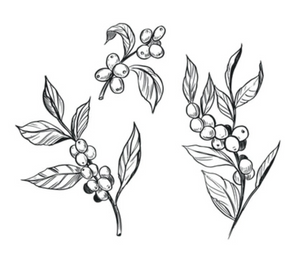I guess it's about time for our first blog post... :) how about a quick overview of green coffee?
Coffee isn't in fact a bean at all! It's a seed found inside a tart "cherry" fruit. The pulp of which is not super edible, but it is sometimes made into a tea called Cascara.
Coffee grows all over the equatorial world. It wants warmth and humidity, but not too much heat or sun. Very finicky little plant. It takes 3 years for each coffee "tree" (more like shrubby bush) to mature in a greenhouse before it is ready to bear fruit. Each plant will then produce around 1lb of green coffee per year for about 5 years before it's done producing.
Coffee cherries must be harvested when properly ripe, then processed and milled before making their way to the roaster.
Dry processing (aka "natural" processing) is when the coffee cherries are sun-dried before being milled. This produces more body in the coffee, and imparts more bold, often tart fruity flavors from the seed soaking in the coffee fruit while it dries in the sun for 2-4 weeks. In darker roasts, dry processed coffee often has heavier body.
Naturals are typically sun-dried on raised beds, however the traditional "Aceh" wet-hulled processing method of Indonesia involves drying and turning the coffee in the soil. Ever wonder why your sumatra tastes earthy?
Wet processing is when the ripe cherries are taken straight to a larger, more sophisticated mill for immediate processing. The cherries are de-pulped, fermented, then milled once more to remove the final "parchment" layer from the seed before it is dried and ready for the roaster.
So as you can see, there is a wide world of coffee before it even gets roasted! Farmers around the world are always raising the bar, experimenting with new fermentation and processing techniques (more on this in the future!), and we're super excited to see what they offer next! Stay Caffeinated~ Will

